We are aiming to build up a collection of pictures of plants, particularly wild flowers photographed growing in Ryedale. The photos are roughly in order of flowering through the year. Plants flowering January-April and May-June are in different files. Also more for July onwards. (This page could take a while for all the pictures to load...)
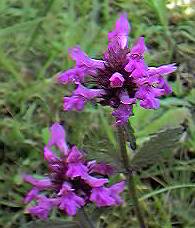 | Betony, Stachys officinalis
Quite common in rough grassland, scrub etc., betony is a member of the mint family and has the characteristic 2-lipped flowers of this group. The flowers are a very distinct shade of reddish-purple, at the top of the whole plant which is up to about a foot tall. The leaves are rather widely-spaced up the stem. 5.7.99 |
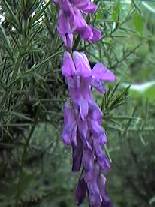 | Tufted Vetch, Vicia cracca
One of the two commonest vetches (the other is Bush Vetch, V.sepium), this plant has its flowers in one-sided heads on longish stalks. The flowers are purplish-blue, and this particular specimen was unusally large and lush. The plant scrambles up other vegetation with the tendrils at the tips of its pinnate leaves. It is very common in verges and hedge bottoms. 5.7.99 |
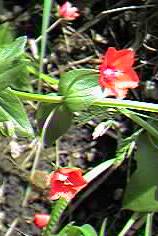 | Scarlet Pimpernel, Anagallis arvensis
 Scarlet pimpernel is not found all that often, but is widely distributed. It grows in waste places, on bare and disturbed ground. The seeds must lie dormant for many years, as it often pops up when an area is dug over for example. The flowers (detail (right), showing the purple central eye) only open widely in the full sun, closing at night and in dull weather. This plant was flowering very profusely. 5.7.99 Scarlet pimpernel is not found all that often, but is widely distributed. It grows in waste places, on bare and disturbed ground. The seeds must lie dormant for many years, as it often pops up when an area is dug over for example. The flowers (detail (right), showing the purple central eye) only open widely in the full sun, closing at night and in dull weather. This plant was flowering very profusely. 5.7.99 |
 | Thyme, Thymus polytrichus
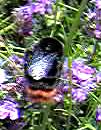 Wild thyme is a much smaller, neater plant than the garden herb, but has the characteristic aromatic smell when the leaves are crushed. It grows, often in mats, in short limestone turf or even directly on the rock; it loves warm, dry, south-facing slopes, and is much appreciated by butterflies and bumble bees (right). 5.7.99 Wild thyme is a much smaller, neater plant than the garden herb, but has the characteristic aromatic smell when the leaves are crushed. It grows, often in mats, in short limestone turf or even directly on the rock; it loves warm, dry, south-facing slopes, and is much appreciated by butterflies and bumble bees (right). 5.7.99 |
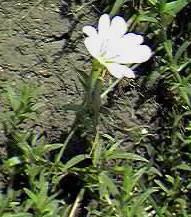 | Field Mouse Ear, Cerastium arvensis
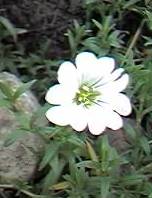 An unusual plant in Ryedale, characteristic of undisturbed limestone grassland. The flowers are relatively large, very similar to the garden “snow in summer” to which it is related, but the leaves are small and neat, often growing in a mat. At least on this Ryedale site (a warm, south-facing slope on the limestone) the flowers are only produced occasionally, such that there were about three flowers for a mat of leaves several feet across! 5.7.99 An unusual plant in Ryedale, characteristic of undisturbed limestone grassland. The flowers are relatively large, very similar to the garden “snow in summer” to which it is related, but the leaves are small and neat, often growing in a mat. At least on this Ryedale site (a warm, south-facing slope on the limestone) the flowers are only produced occasionally, such that there were about three flowers for a mat of leaves several feet across! 5.7.99 |
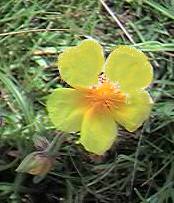 | Rockrose, Helianthemum nummularium
This delightful flower is a real marker of limestone. It grows in undisturbed grassland, especially on sunny slopes where the turf is very short, perhaps because of grazing by either rabbits or sheep (although this can be counter-productive as the animals eat the flower-spikes!). The yellow flowers are about an inch across, and usually occur in loose spikes of 3 or 4. They are very like the various garden rockroses but rather more delicate. 5.7.99 |
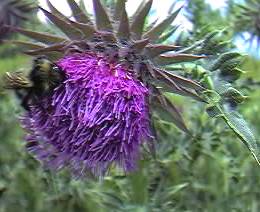 | Musk Thistle, Carduus nutans
This thistle tends to grow on limestone, usually in short grass or on quarry waste. The large, deep purple flowers are fragrant, and drooping or nodding in bud. They have very pronounced spiny sepal-like bracts. This splendid specimen had a furry bumble-bee feeding on it. This thistle was photographed in the same field as the rockrose, field mouse-ear and thyme above. (Compare with the much commoner Spear thistle) 5.7.99 |
 | Yarrow, Achillea millefolium
A common weed in grass verges, old lawns and so on. The flowers are usually white, but sometimes pale pink or lilac. The Latin specific of thousand-leafed refers to the very finely-divided leaves which are almost fern-like.25/7/99. |
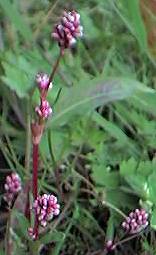 | Redshank or Redleg, Persicaria maculosa
Probably the commonest of the Bistorts or Persicaria family: a frequent weed of disturbed ground, farmyards, pathsides etc. The flowers are usually pink, as here, but sometimes white specimens are seen (note that some of these will be the closely related Pale Persicaria (P. lapathifolia). The leaves often show dark markings.25/7/99. |
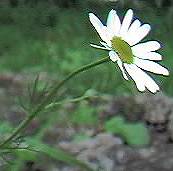 | Mayweed, scentless, Triplospermum maritimum
A common weed of arable fields, related to the (scented) sweet chamomile and pineapple weed (below). Mayweed is a rather untidy plant some 9-12" tall with daisy-like flowers and fine, feathery foliage. 25/7/99. |
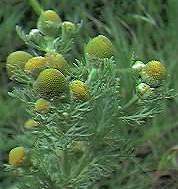 | Pineapple Weed, Matricaria discoidea
Related to the Mayweed above, this little plant is very common in disturbed ground, gateways, farmyards, tracksides etc. It is not actually a native, but clearly finds conditions to its liking. The name is particularly apt as the rayless flowers resemble tiny pineapples, and the whole plant when crushed has a strong sweet scent very reminiscent of pineapples. 25/7/99 |
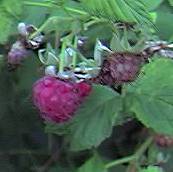 | Raspberry, Rubus idaeus
Wild raspberries closely resemble their cultivated cousins, though the plants tend to be rather untidy and sprawling, and the fruit is generally much smaller, though often sweeter and more fragrant – they make excellent jam if you can ever beat the birds and find enough berries! 25/7/99. |
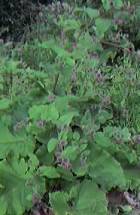 | Burdock, Arctium minus
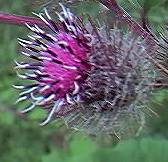 Burdocks can grow very large, over six feet tall, with enormous leaves. Close up, the flowers resemble thistles, though without the prickles (right). Burdocks can grow very large, over six feet tall, with enormous leaves. Close up, the flowers resemble thistles, though without the prickles (right). 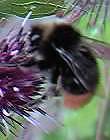 The hooked hairs on the calyx develop into the burrs which attach themselves to passing animals including dogs and humans in order to disperse the seeds. The flowers attract insects such as bumble bees (left). 25/7/99 The hooked hairs on the calyx develop into the burrs which attach themselves to passing animals including dogs and humans in order to disperse the seeds. The flowers attract insects such as bumble bees (left). 25/7/99 |
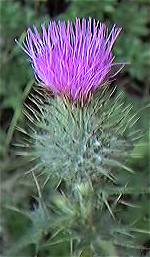 | Thistle, spear, Cirsium vulgare
The commonest large thistle. Spear thistles are well named, bearing numerous very sharp spines, particularly on the calyx: these spines are characteristically tipped in yellow or straw-colour, and are longer and sharper than those of any other common thistles. The scentless flower-heads are upright, in contrast to those of Musk thistles which hang down. 25/7/99 |
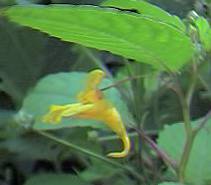 | Balsam, yellow, Impatiens noli-tangere
The only native British balsam, although doubtfully truly native in Ryedale, where it is not common. 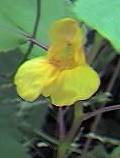 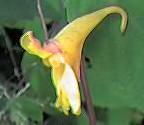 Yellow balsam grows in marshy places and ditches. It is a much smaller plant than the increasingly common pink Himalayan balsam, only reaching two feet or so, and often only about a foot tall. The whole plant is fleshy, almost translucent on the stems, with the striking, spurred yellow flowers (up to an inch across) dangling on long stalks towards the top. The Latin specific and the alternative name of “Touch-me-not” refer to the ripe seed-pods, which spring open at the slightest touch, sending the seeds flying out a considerable distance. 25/7/99. Yellow balsam grows in marshy places and ditches. It is a much smaller plant than the increasingly common pink Himalayan balsam, only reaching two feet or so, and often only about a foot tall. The whole plant is fleshy, almost translucent on the stems, with the striking, spurred yellow flowers (up to an inch across) dangling on long stalks towards the top. The Latin specific and the alternative name of “Touch-me-not” refer to the ripe seed-pods, which spring open at the slightest touch, sending the seeds flying out a considerable distance. 25/7/99. |
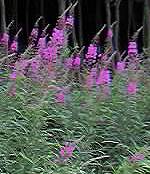 | Willowherb, Rosebay or Fireweed, Chamerion angustifolium
Fireweed rapidly colonises newly cleared areas of woodland and waste land (it is the classic plant of bomb sites in towns) where the dense stands make a fine show. The reddish-purple flowers are followed by prolific white silky seeds so that the “fire” is followed by “smoke”. Rosebay is related to the Epilobium Willowherbs, which are mostly rather small, weedy insignificant plants. Also known as Chamaenerion angustifolia. 25/7/99. |
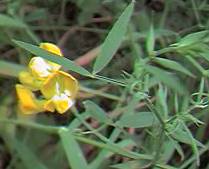 | Meadow Vetchling or Yellow Pea, Lathyrus pratensis
The only common yellow vetch-like flower, meadow peas have pinnate leaves and long curling tendrils with which they scramble up the tall grasses and other plants with which they grow on verges, along the edges of woodland rides etc. The flowers occur in clusters on stalks emerging from the leaf axils. 25/7/99. |
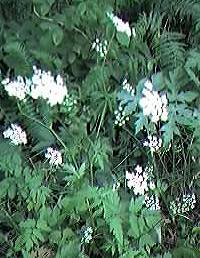 | Burnet Saxifrage, greater, Pimpinella major
Neither a burnet nor a saxifrage! A white umbellifer at first glance similar to cow parsley, but with pinnate leaves and flowering in high summer, this burnet saxifrage is concentrated in the Ampleforth area, usually growing on limestone (the smaller Pimpinella saxifraga grows in the same area, but has different upper leaves). 25/7/99. |
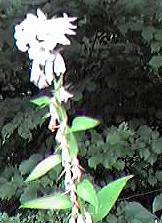 | Bellflower, greater, Campanula latifolia
A striking plant, rather like a tall Canterbury bell. Great bellflowers are common in old woodland, especially on limy soils along the edges in dappled shade. The flowers vary from white through pale mauve-blue (the commonest form) to quite deep purple, and often occur in stands of twenty or so. The plants, up to 4' tall, are very conspicuous for the week or so in which the flowers are out but remarkably well hidden for the rest of the year. 25/7/99. |
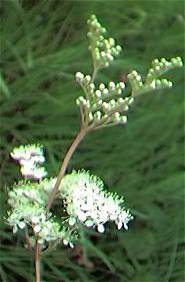 | Meadowsweet, Filipendula ulmaria
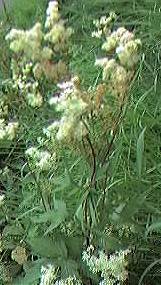 An old favourite, the heady scent of meadowsweet is synonymous with the English summer... a plant of damp meadows, ditches and streamsides it is sadly not as common as it used to be as damp areas have been drained, but good stands can still be found in Ryedale (right).25/7/99. An old favourite, the heady scent of meadowsweet is synonymous with the English summer... a plant of damp meadows, ditches and streamsides it is sadly not as common as it used to be as damp areas have been drained, but good stands can still be found in Ryedale (right).25/7/99. |
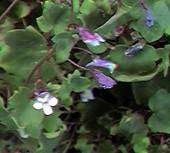 | Toadflax, ivy leaved, Cymbalaria muralis
An introduced plant (originally from southern Europe, but recorded in Britain since 1640), ivy-leaved toadflax is now common on walls and paths near houses. The miniature snapdragon-like flowers are very pretty; occasionally an albino form is seen, probably a more recent garden escape. 25/7/99. |
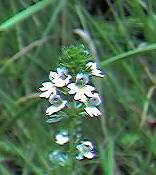 | Eyebright, Euphrasia sp.
Eyebright is a very common little plant of woodland rides, short grassland, roadside verges etc., and also grows on the moors. There are numerous sub-species but they are hard to tell apart; the flowers are usually white or pale mauve, with yellow throats and fine dark “honey-guides” for insects. The name derives from its use in folk medicine for eye complaints. Related to red bartsia. 31/8/99. |
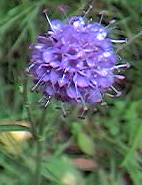 | Devil’s bit Scabious, Succisa pratensis
A pretty blue scabious flowering in late summer. 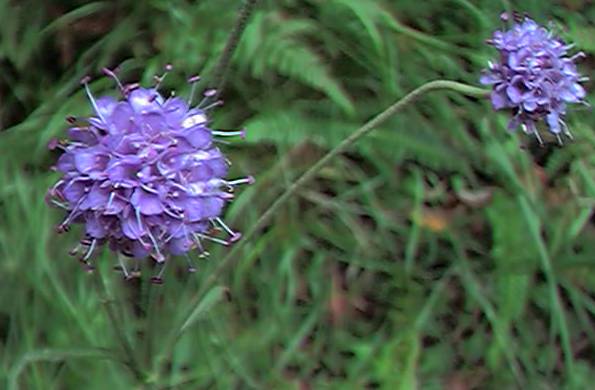 Unlike the lime-loving true scabious, this grows in damp woodland or sometimes moorland on acid or neutral soils, and has simple rather than pinnately lobed leaves. The curious name is said to come from the fact that the rootstock is very short and appears to be bitten off! Click on the picture to the right for an enlargement... 31/8/99. Unlike the lime-loving true scabious, this grows in damp woodland or sometimes moorland on acid or neutral soils, and has simple rather than pinnately lobed leaves. The curious name is said to come from the fact that the rootstock is very short and appears to be bitten off! Click on the picture to the right for an enlargement... 31/8/99. |
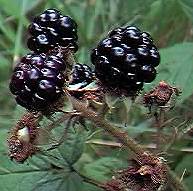 | Blackberry, Rubus fruticosus
One of the joys of autumn, ripe blackberries! These were growing on a trackside in woodland, but they are common on all kinds of waste ground, rough hillsides etc. 31/8/99. |
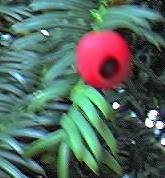 | Yew, Taxus baccata
At this time of year the fleshy red arils covering the yew’s seeds are very conspicuous, but only on some trees as the male and female flowers occur on separate plants. 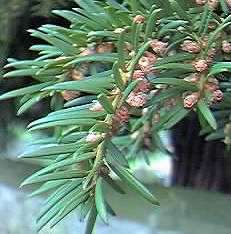 The picture right shows male flowers in March (22/3/2000), just about to shed pollen. Yews are native to Ryedale, but most of those we see have been planted. Yew is very poisonous, so it is rarely seen on farmland where stock might be able to reach it. Interestingly birds seem to be able to eat the seeds without harm. 13/9/99. The picture right shows male flowers in March (22/3/2000), just about to shed pollen. Yews are native to Ryedale, but most of those we see have been planted. Yew is very poisonous, so it is rarely seen on farmland where stock might be able to reach it. Interestingly birds seem to be able to eat the seeds without harm. 13/9/99. |
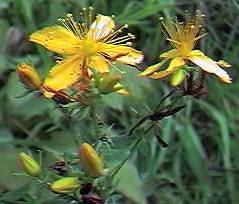 | St. Johnswort, common or perforate, Hypericum perforatum
Several species of St. Johnswort grow in Ryedale; they all have very similar yellow flowers and most bloom in summer. This example is a late specimen of the so-called Common St. Johnswort, growing on the edge of a fairly dry woodland ride. Its alternative name alludes to the many translucent spots on the leaves, which look like perforations or holes when held up to the light. It has two raised lines on the main stem, which help to separate it from other common species. 13/9/99. |
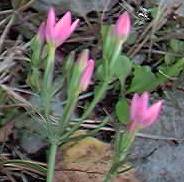 | Centaury, Centaurium erythraea
Centaury is a member of the gentian family, but has flowers of a clear pink rather than blue. It is common but patchy, growing along the edges of dry, often sandy woodland paths and tracks. This specimen was a late-comer, as it is usually at its best in high summer. The flowers are a very charactersitic colour, so the plant can be spotted and identified from some distance away! 13/9/99. |
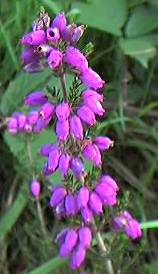 | Bell heather, Erica cinerea
One of three heathers common in Ryedale, the Bell heather, also known as Scots heather, has flowers of a clear, dark purple which grow right up the stem. It sometimes forms considerable clumps, but is more commonly found as individual plants, often along tracksides on the moors. It also grows in heathy woodland under light shade, often from birch or larch trees. 13/9/99 |
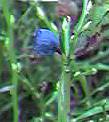 | Bilberry, Vaccinium myrtillus
The blue-black bilberry makes wonderful pies if you have the patience to pick enough! A member of the heath family, this undershrub is common on the moors and in woodland throughout Ryedale, preferring acid soils. Where sheep can reach it the plants are often dwarfed and only a couple of inches tall (the sheep eat the berries too), but in woods or inaccessible corners they can reach a foot or so. 13/9/99 |
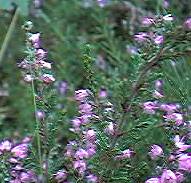 | Heather, Calluna vulgaris
Ling or Heather is by far the commonest of the heathers growing on the moors, forming a mauve-purple sward for a couple of weeks at the end of August/beginning of September. The normal colour is lilac, 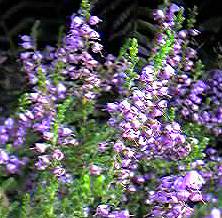 but there is considerable variation with some much darker and some distinctly pink specimens – and of course the occasional albino white heather. It prefers the drier slopes, damper areas tending to be colonised by cross-leaved heath. Ling also grows as an undershrub in sandy woodland, avoiding limestone (as do most members of the Ericaceae). 13/9/99 but there is considerable variation with some much darker and some distinctly pink specimens – and of course the occasional albino white heather. It prefers the drier slopes, damper areas tending to be colonised by cross-leaved heath. Ling also grows as an undershrub in sandy woodland, avoiding limestone (as do most members of the Ericaceae). 13/9/99 |
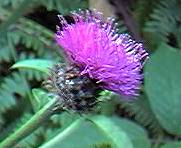 | Knapweed, common, Centaurea nigra
Common knapweed or Hardheads provide a wonderful blaze of colour in late summer, growing in rough grassland, on tracksides, in woods, on commons, verges, etc. They grow on a wide variety of soil types, unlike relatives such as the scabiouses or Greater Knapweed which require limestone. Knapweed flowers attract many different insects, including bumble-bees, butterflies and hoverflies. 13/9/99 |
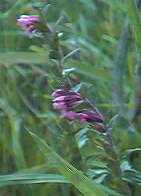 | Red Bartsia, Odontites verna
A relative of eyebright, red bartsia is a semi-parasite, gaining some of its food through roots which attach themselves to those of other plants, chiefly grasses. A common little flower in rough grassland, old cornfields etc., and recently on set-aside land. 13/9/99 |
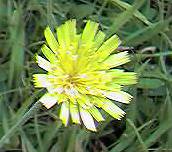 | Hawkweed, mouse eared, Hieracium pilosella
A common plant of late summer, resembling a small dandelion. Mouse-eared hawkweed is one of the easier of the dandelion-like flowers to identify as the blooms are a charactersitic lemon- or primrose-yellow, with the leaves in a basal rosette, covered in whitish-grey hair beneath. An attractive little plant, growing in short grassland. 13/9/99 |
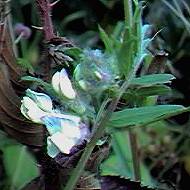 | Vetch, wood, Vicia sylvatica
An uncommon vetch, usually flowering in August, and growing in woodland, often at the edges such as along track-sides; it seems to prefer limy, or at least neutral soils (and also grows at the sea-side). 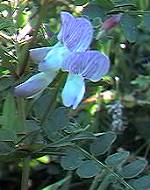 The flowers are white with very fine, delicate purple lines leading into the “throat”, presumably as honey-guides for insects. Unfortunately the photo doesn’t really show these beautiful vein-like markings. This rather late specimen was growing at the side of a woodland track entangled with brambles (13/9/99). The detail (right) was photographed at Sandsend 30/8/2000 The flowers are white with very fine, delicate purple lines leading into the “throat”, presumably as honey-guides for insects. Unfortunately the photo doesn’t really show these beautiful vein-like markings. This rather late specimen was growing at the side of a woodland track entangled with brambles (13/9/99). The detail (right) was photographed at Sandsend 30/8/2000 |
 | Ivy, Hedera helix
One of the few plants to flower in the autumn, ivy produces these heads of green flowers from September onwards. They have a curious scent, which attracts all kinds of insects, particularly flies and hoverflies, to pollinate the flowers. These then develop into curious black berries. This particular plant was growing on a garden wall in Gilling and flowering profusely. 11/10/99 |
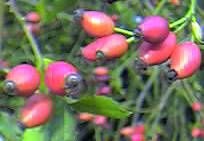 | Rose hips, Rosa canina
Rose hips are very colourful in the autumn. They used to be collected for rose-hip syprup, but now
they are left for the birds. These are almost certainly the hips of the dog
rose, and were photographed in woodland. 24/10/99 |
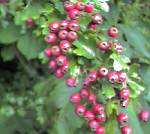 | Hawthorn berries, Crataegus monogyna
Along with rose hips probably the commonest red berries in the hedges in autumn, providing food for many birds. It is sad to see so many hedges flailed in late summer before the haws are fully ripe. 12/9/2000 |
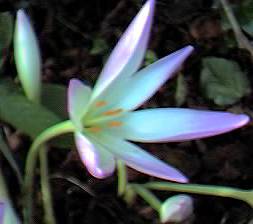
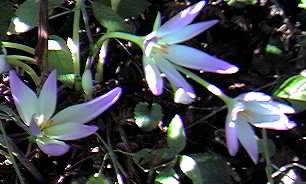 | Meadow Saffron, Colchicum autumnale
A more delicate version of the garden Colchicum, these flowers appeared to be growing wild in a hedge bottom, but may be a relic of cultivation, perhaps from a monastic herb garden. This is a rare plant in the wild, but was cultivated in olden times for medicinal purposes (the drug colchicine is extracted from it); it is poisonous. The flowers appear in late September or early October as if by magic, with the rather broad green leaves coming quite separately in the spring. At first glance these relatives of the lily look like crocuses, but they can be distinguished by having 6 stamens (the superficially similar autumn crocus, which is not native, has 3 and large feathery orange stigmas). The name “Meadow Saffron” is actually misleading, as the spice saffron is from a true crocus, being the dried stigmas. The detail (top) shows a single flower with a bud behind, and the picture below shows a group of several individuals. 16/9/2000. |
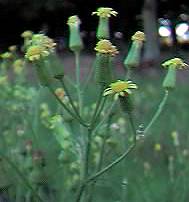 | Heath Groundsel, Senecio sylvaticus
Rather like cross between a weak ragwort and a taller version of the common weed Groundsel (and closely related to both), with scattered cottony hairs on the stem and leaves. The petals or rays of the outer florets are very short and soon roll back on themselves (see the flowers near the middle of the picture, which is a detail of one of the clusters of flowerheads on a fairly bushy plant). The plant is some two or three feet tall, and grows in heathy woodland, particularly in recently felled clearings. This specimen was one of a group growing near Gilling on an area that was felled just about a year ago. 8/10/2000. |
 | Acorns, Quercus sp.
A small group of well developed acorns; They have short stalks, which suggests that this tree is a hybrid between the two common oaks Q. robur (with long-stalked acorns) and Q. petraea (which has acorns with almost no stalks). 2000 was a good year for acorns. 8/10/2000. |
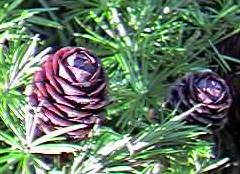 | Larch cones, Larix sp.
This photo shows the very attractive young cones of larch, which are still quite soft at this stage, and deep pink. Later they will harden and become brown, with the seeds attached to papery scales so that they can be blown away by the wind. The seeds are a favourite food of many birds such as siskins and crossbills, which are often to be seen and heard feasting in the tree-tops. 8/10/2000. |
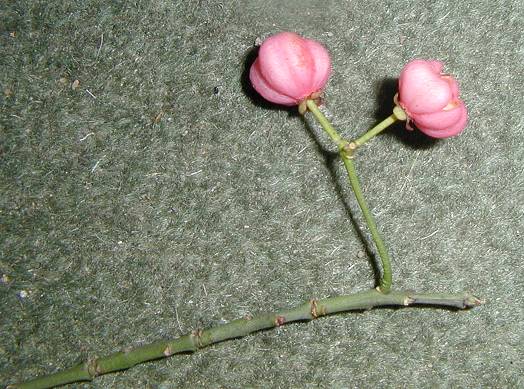 |
Spindle, Euonymus europaeus
Spindle is a small tree that grows on limestone, usually in old woodland. In spring it has small rather unimpressive greenish flowers that develop in autumn into these interesting pink fruits. Spindle trees are not common in Ryedale, but there are a few specimens along the limestone ridge around Nunnington, although this individual is near Gilling. |



 Scarlet pimpernel is not found all that often, but is widely distributed. It grows in waste places, on bare and disturbed ground. The seeds must lie dormant for many years, as it often pops up when an area is dug over for example. The flowers (detail (right), showing the purple central eye) only open widely in the full sun, closing at night and in dull weather. This plant was flowering very profusely. 5.7.99
Scarlet pimpernel is not found all that often, but is widely distributed. It grows in waste places, on bare and disturbed ground. The seeds must lie dormant for many years, as it often pops up when an area is dug over for example. The flowers (detail (right), showing the purple central eye) only open widely in the full sun, closing at night and in dull weather. This plant was flowering very profusely. 5.7.99
 Wild thyme is a much smaller, neater plant than the garden herb, but has the characteristic aromatic smell when the leaves are crushed. It grows, often in mats, in short limestone turf or even directly on the rock; it loves warm, dry, south-facing slopes, and is much appreciated by butterflies and bumble bees (right). 5.7.99
Wild thyme is a much smaller, neater plant than the garden herb, but has the characteristic aromatic smell when the leaves are crushed. It grows, often in mats, in short limestone turf or even directly on the rock; it loves warm, dry, south-facing slopes, and is much appreciated by butterflies and bumble bees (right). 5.7.99
 An unusual plant in Ryedale, characteristic of undisturbed limestone grassland. The flowers are relatively large, very similar to the garden “snow in summer” to which it is related, but the leaves are small and neat, often growing in a mat. At least on this Ryedale site (a warm, south-facing slope on the limestone) the flowers are only produced occasionally, such that there were about three flowers for a mat of leaves several feet across! 5.7.99
An unusual plant in Ryedale, characteristic of undisturbed limestone grassland. The flowers are relatively large, very similar to the garden “snow in summer” to which it is related, but the leaves are small and neat, often growing in a mat. At least on this Ryedale site (a warm, south-facing slope on the limestone) the flowers are only produced occasionally, such that there were about three flowers for a mat of leaves several feet across! 5.7.99







 Burdocks can grow very large, over six feet tall, with enormous leaves. Close up, the flowers resemble thistles, though without the prickles (right).
Burdocks can grow very large, over six feet tall, with enormous leaves. Close up, the flowers resemble thistles, though without the prickles (right).  The hooked hairs on the calyx develop into the burrs which attach themselves to passing animals including dogs and humans in order to disperse the seeds. The flowers attract insects such as bumble bees (left). 25/7/99
The hooked hairs on the calyx develop into the burrs which attach themselves to passing animals including dogs and humans in order to disperse the seeds. The flowers attract insects such as bumble bees (left). 25/7/99


 Yellow balsam grows in marshy places and ditches. It is a much smaller plant than the increasingly common pink Himalayan balsam, only reaching two feet or so, and often only about a foot tall. The whole plant is fleshy, almost translucent on the stems, with the striking, spurred yellow flowers (up to an inch across) dangling on long stalks towards the top. The Latin specific and the alternative name of “Touch-me-not” refer to the ripe seed-pods, which spring open at the slightest touch, sending the seeds flying out a considerable distance. 25/7/99.
Yellow balsam grows in marshy places and ditches. It is a much smaller plant than the increasingly common pink Himalayan balsam, only reaching two feet or so, and often only about a foot tall. The whole plant is fleshy, almost translucent on the stems, with the striking, spurred yellow flowers (up to an inch across) dangling on long stalks towards the top. The Latin specific and the alternative name of “Touch-me-not” refer to the ripe seed-pods, which spring open at the slightest touch, sending the seeds flying out a considerable distance. 25/7/99.




 An old favourite, the heady scent of meadowsweet is synonymous with the English summer... a plant of damp meadows, ditches and streamsides it is sadly not as common as it used to be as damp areas have been drained, but good stands can still be found in Ryedale (right).25/7/99.
An old favourite, the heady scent of meadowsweet is synonymous with the English summer... a plant of damp meadows, ditches and streamsides it is sadly not as common as it used to be as damp areas have been drained, but good stands can still be found in Ryedale (right).25/7/99.





 The picture right shows male flowers in March (22/3/2000), just about to shed pollen. Yews are native to Ryedale, but most of those we see have been planted. Yew is very poisonous, so it is rarely seen on farmland where stock might be able to reach it. Interestingly birds seem to be able to eat the seeds without harm. 13/9/99.
The picture right shows male flowers in March (22/3/2000), just about to shed pollen. Yews are native to Ryedale, but most of those we see have been planted. Yew is very poisonous, so it is rarely seen on farmland where stock might be able to reach it. Interestingly birds seem to be able to eat the seeds without harm. 13/9/99.




 but there is considerable variation with some much darker and some distinctly pink specimens – and of course the occasional albino white heather. It prefers the drier slopes, damper areas tending to be colonised by cross-leaved heath. Ling also grows as an undershrub in sandy woodland, avoiding limestone (as do most members of the Ericaceae). 13/9/99
but there is considerable variation with some much darker and some distinctly pink specimens – and of course the occasional albino white heather. It prefers the drier slopes, damper areas tending to be colonised by cross-leaved heath. Ling also grows as an undershrub in sandy woodland, avoiding limestone (as do most members of the Ericaceae). 13/9/99



 The flowers are white with very fine, delicate purple lines leading into the “throat”, presumably as honey-guides for insects. Unfortunately the photo doesn’t really show these beautiful vein-like markings. This rather late specimen was growing at the side of a woodland track entangled with brambles (13/9/99). The detail (right) was photographed at Sandsend 30/8/2000
The flowers are white with very fine, delicate purple lines leading into the “throat”, presumably as honey-guides for insects. Unfortunately the photo doesn’t really show these beautiful vein-like markings. This rather late specimen was growing at the side of a woodland track entangled with brambles (13/9/99). The detail (right) was photographed at Sandsend 30/8/2000







